朗文新派少儿英语入门级1 Unit 3 My Body
- 格式:ppt
- 大小:1.22 MB
- 文档页数:20
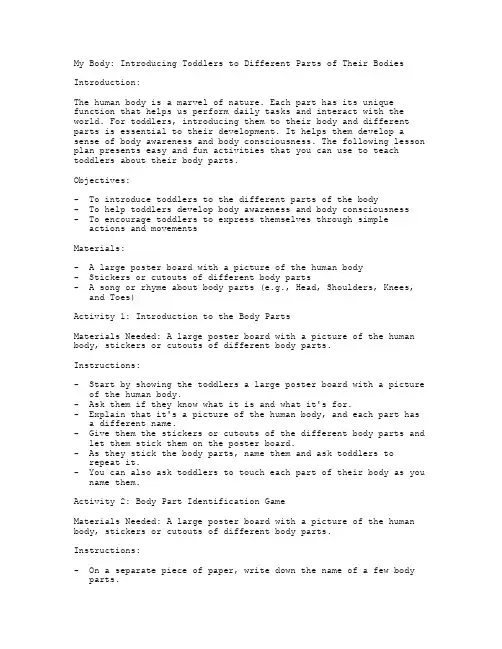
My Body: Introducing Toddlers to Different Parts of Their Bodies Introduction:The human body is a marvel of nature. Each part has its unique function that helps us perform daily tasks and interact with the world. For toddlers, introducing them to their body and different parts is essential to their development. It helps them develop a sense of body awareness and body consciousness. The following lesson plan presents easy and fun activities that you can use to teach toddlers about their body parts.Objectives:-To introduce toddlers to the different parts of the body-To help toddlers develop body awareness and body consciousness-To encourage toddlers to express themselves through simple actions and movementsMaterials:- A large poster board with a picture of the human body-Stickers or cutouts of different body parts- A song or rhyme about body parts (e.g., Head, Shoulders, Knees, and Toes)Activity 1: Introduction to the Body PartsMaterials Needed: A large poster board with a picture of the human body, stickers or cutouts of different body parts.Instructions:-Start by showing the toddlers a large poster board with a picture of the human body.-Ask them if they know what it is and what it's for.-Explain that it's a picture of the human body, and each part hasa different name.-Give them the stickers or cutouts of the different body parts and let them stick them on the poster board.-As they stick the body parts, name them and ask toddlers to repeat it.-You can also ask toddlers to touch each part of their body as you name them.Activity 2: Body Part Identification GameMaterials Needed: A large poster board with a picture of the human body, stickers or cutouts of different body parts.Instructions:-On a separate piece of paper, write down the name of a few body parts.-Ask the toddlers to identify each body part on the poster board and stick the corresponding sticker on the body part.-For example, if you write "nose" on the paper, the toddlers should stick the corresponding sticker onto the nose on theposter board.-Continue until all the body parts have been identified.Activity 3: Body Parts Song or RhymeMaterials Needed: A song or rhyme about body parts (e.g., Head, Shoulders, Knees, and Toes).Instructions:-Teach the toddlers a song or rhyme about body parts.-Use simple actions and movements along with the lyrics to help toddlers remember the song.-"Head, Shoulders, Knees, and Toes" is a popular and fun song that children love.-Encourage toddlers to sing along and use the actions to identify each body part.Conclusion:Teaching toddlers about different parts of their bodies is an important developmental step. It helps them understand body awareness, body consciousness and develop self-confidence. The activities mentioned above provide an engaging and fun way of introducing toddlers to their body parts. Use these activities to help toddlers appreciate and understand their bodies and the vital role each part plays in their lives.。
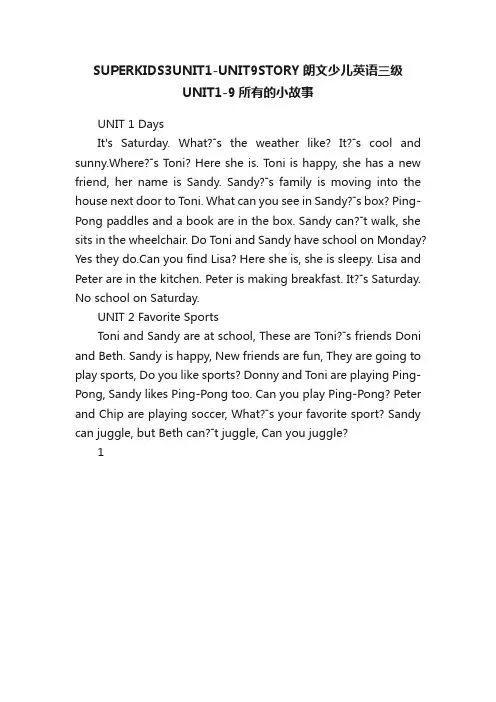
SUPERKIDS3UNIT1-UNIT9STORY朗文少儿英语三级UNIT1-9所有的小故事UNIT 1 DaysIt's Saturday. What?ˉs the weather like? It?ˉs cool and sunny.Where?ˉs T oni? Here she is. T oni is happy, she has a new friend, her name is Sandy. Sandy?ˉs family is moving into the house next door to Toni. What can you see in Sandy?ˉs box? Ping-Pong paddles and a book are in the box. Sandy can?ˉt walk, she sits in the wheelchair. Do Toni and Sandy have school on Monday? Yes they do.Can you find Lisa? Here she is, she is sleepy. Lisa and Peter are in the kitchen. Peter is making breakfast. It?ˉs Saturday. No school on Saturday.UNIT 2 Favorite SportsToni and Sandy are at school, These are Toni?ˉs friends Doni and Beth. Sandy is happy, New friends are fun, They are going to play sports, Do you like sports? Donny and Toni are playing Ping-Pong, Sandy likes Ping-Pong too. Can you play Ping-Pong? Peter and Chip are playing soccer, What?ˉs your favorite sport? Sandy can juggle, b ut Beth can?ˉt juggle, Can you juggle?1。
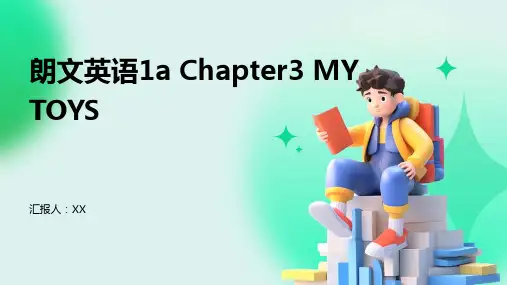
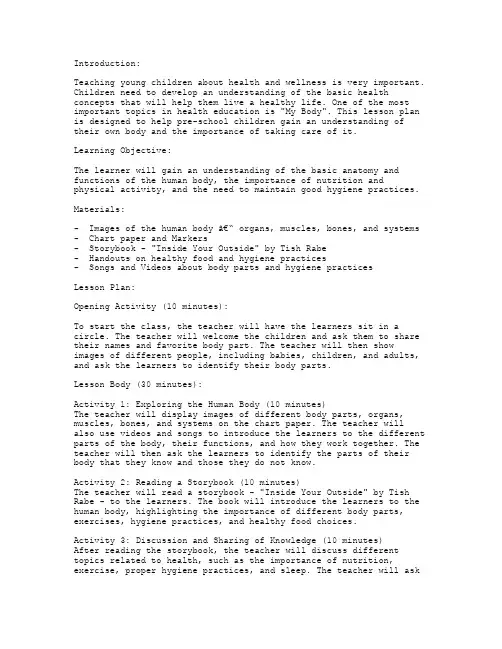
Introduction:Teaching young children about health and wellness is very important. Children need to develop an understanding of the basic health concepts that will help them live a healthy life. One of the most important topics in health education is "My Body". This lesson plan is designed to help pre-school children gain an understanding oftheir own body and the importance of taking care of it.Learning Objective:The learner will gain an understanding of the basic anatomy and functions of the human body, the importance of nutrition andphysical activity, and the need to maintain good hygiene practices. Materials:-Images of the human body – organs, muscles, bones, and systems-Chart paper and Markers-Storybook - "Inside Your Outside" by Tish Rabe-Handouts on healthy food and hygiene practices-Songs and Videos about body parts and hygiene practicesLesson Plan:Opening Activity (10 minutes):To start the class, the teacher will have the learners sit in a circle. The teacher will welcome the children and ask them to share their names and favorite body part. The teacher will then show images of different people, including babies, children, and adults, and ask the learners to identify their body parts.Lesson Body (30 minutes):Activity 1: Exploring the Human Body (10 minutes)The teacher will display images of different body parts, organs, muscles, bones, and systems on the chart paper. The teacher willalso use videos and songs to introduce the learners to the different parts of the body, their functions, and how they work together. The teacher will then ask the learners to identify the parts of their body that they know and those they do not know.Activity 2: Reading a Storybook (10 minutes)The teacher will read a storybook - "Inside Your Outside" by Tish Rabe - to the learners. The book will introduce the learners to the human body, highlighting the importance of different body parts, exercises, hygiene practices, and healthy food choices.Activity 3: Discussion and Sharing of Knowledge (10 minutes)After reading the storybook, the teacher will discuss different topics related to health, such as the importance of nutrition, exercise, proper hygiene practices, and sleep. The teacher will askthe learners to share their knowledge and experiences about how they take care of their body.Activity 4: Handout (10 minutes)The teacher will distribute handouts on healthy food and hygiene practices. The learners will be encouraged to color the pictures and share their learning with their parents or guardians.Closing Activity (10 minutes):To end the class, the teacher will review the learning objectives, and the learners will be allowed to ask questions if there are any. The teacher will then ask the learners to share the most important thing they learned from the lesson. The learners will also be asked to stand up, stretch, and do some simple physical activities to reinforce the importance of exercise for overall health.Conclusion:Teaching pre-schoolers about their body is an important part of health education. It helps them understand the importance of maintaining good health practices, such as eating healthy food, regular exercise, and proper hygiene. With this lesson, learnerswill gain an understanding of how their body works and why it is important to take care of it. This will help them make betterchoices about their health and wellness, leading to a healthier and happier life.。
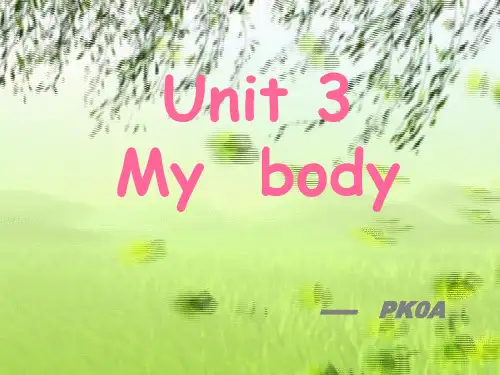
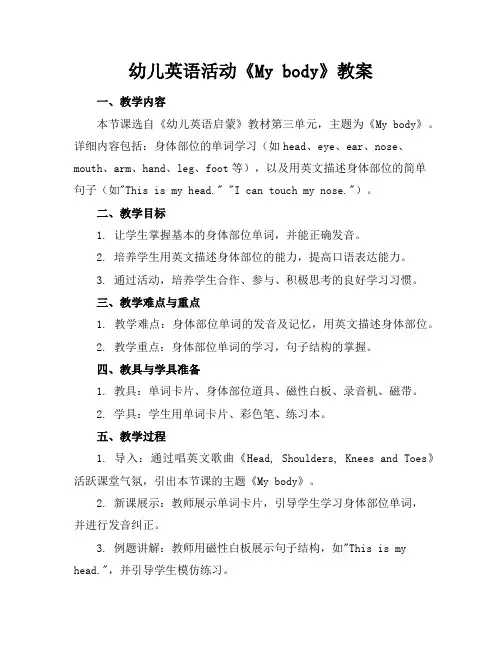
幼儿英语活动《My body》教案一、教学内容本节课选自《幼儿英语启蒙》教材第三单元,主题为《My body》。
详细内容包括:身体部位的单词学习(如head、eye、ear、nose、mouth、arm、hand、leg、foot等),以及用英文描述身体部位的简单句子(如"This is my head." "I can touch my nose.")。
二、教学目标1. 让学生掌握基本的身体部位单词,并能正确发音。
2. 培养学生用英文描述身体部位的能力,提高口语表达能力。
3. 通过活动,培养学生合作、参与、积极思考的良好学习习惯。
三、教学难点与重点1. 教学难点:身体部位单词的发音及记忆,用英文描述身体部位。
2. 教学重点:身体部位单词的学习,句子结构的掌握。
四、教具与学具准备1. 教具:单词卡片、身体部位道具、磁性白板、录音机、磁带。
2. 学具:学生用单词卡片、彩色笔、练习本。
五、教学过程1. 导入:通过唱英文歌曲《Head, Shoulders, Knees and Toes》活跃课堂气氛,引出本节课的主题《My body》。
2. 新课展示:教师展示单词卡片,引导学生学习身体部位单词,并进行发音纠正。
3. 例题讲解:教师用磁性白板展示句子结构,如"This is my head.",并引导学生模仿练习。
4. 随堂练习:学生两人一组,互相描述对方的身体部位,巩固单词和句子。
5. 小游戏:组织学生进行“Touch your body parts”游戏,教师说身体部位单词,学生迅速触摸相应的部位,提高反应能力和单词记忆。
六、板书设计1. 板书《My body》2. 内容:身体部位单词、句子结构、例句。
七、作业设计1. 作业题目:用英文描述自己的身体部位,并画出来。
2. 答案示例:This is my head. I have big eyes. I can touch my nose.八、课后反思及拓展延伸1. 反思:关注学生在课堂上的发音准确性,加强个别辅导,提高学习效果。
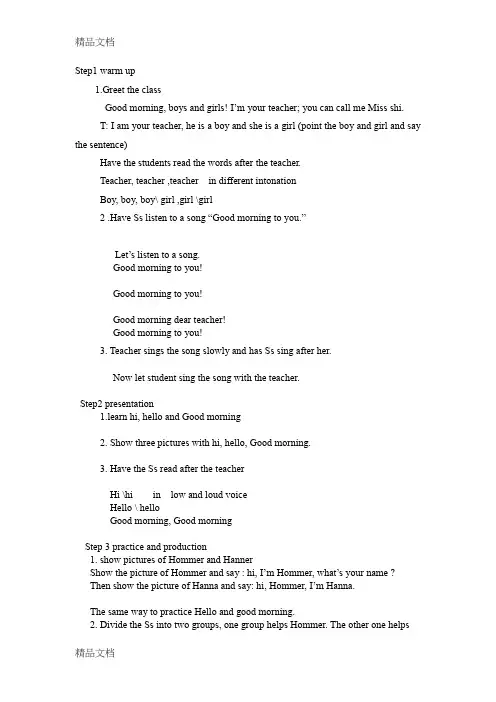
Step1 warm up1.Greet the classGood morning, boys and girls! I’m your teacher; you can call me Miss shi.T: I am your teacher, he is a boy and she is a girl (point the boy and girl and say the sentence)Have the students read the words after the teacher.Teacher, teacher ,teacher in different intonationBoy, boy, boy\ girl ,girl \girl2 .Have Ss listen to a song “Good morning to you.”L et’s listen to a song.Good morning to you!Good morning to you!Good morning dear teacher!Good morning to you!3. Teacher sings the song slowly and has Ss sing after her.Now let student sing the song with the teacher.Step2 presentation1.learn hi, hello and Good morning2. Show three pictures with hi, hello, Good morning.3. Have the Ss read after the teacherHi \hi in low and loud voiceHello \ helloGood morning, Good morningStep 3 practice and production1. show pictures of Hommer and HannerShow the picture of Hommer and say : hi, I’m Hommer, what’s your name ?Then show the picture of Hanna and say: hi, Hommer, I’m Hanna.The same way to practice Hello and good morning.2. Divide the Ss into two groups, one group helps Hommer. The other one helpsHanna.Now let two groups greet each other.。
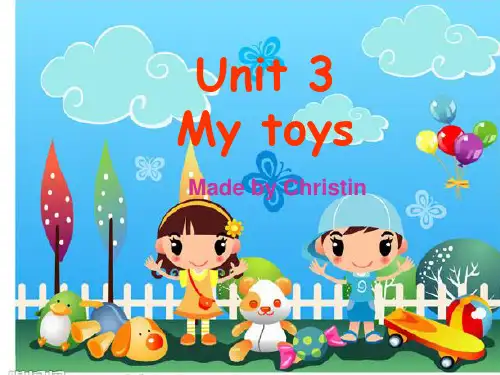
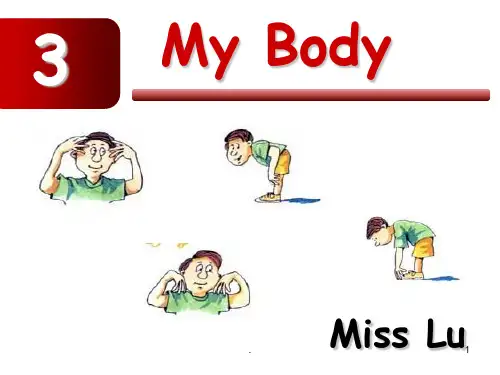
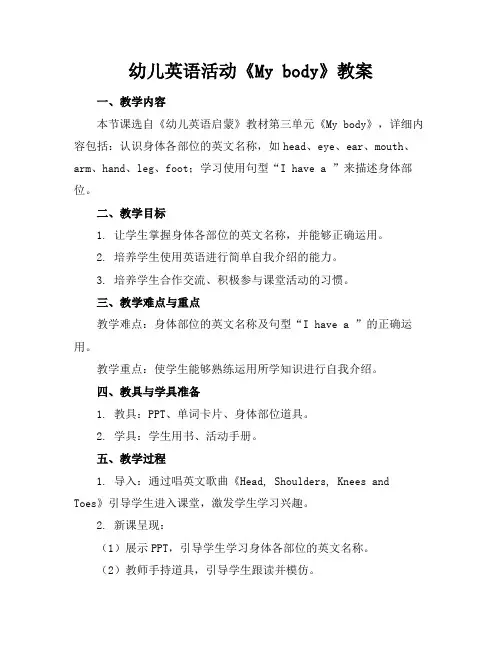
幼儿英语活动《My body》教案一、教学内容本节课选自《幼儿英语启蒙》教材第三单元《My body》,详细内容包括:认识身体各部位的英文名称,如head、eye、ear、mouth、arm、hand、leg、foot;学习使用句型“I have a ”来描述身体部位。
二、教学目标1. 让学生掌握身体各部位的英文名称,并能够正确运用。
2. 培养学生使用英语进行简单自我介绍的能力。
3. 培养学生合作交流、积极参与课堂活动的习惯。
三、教学难点与重点教学难点:身体部位的英文名称及句型“I have a ”的正确运用。
教学重点:使学生能够熟练运用所学知识进行自我介绍。
四、教具与学具准备1. 教具:PPT、单词卡片、身体部位道具。
2. 学具:学生用书、活动手册。
五、教学过程1. 导入:通过唱英文歌曲《Head, Shoulders, Knees and Toes》引导学生进入课堂,激发学生学习兴趣。
2. 新课呈现:(1)展示PPT,引导学生学习身体各部位的英文名称。
(2)教师手持道具,引导学生跟读并模仿。
(3)教师用句型“I have a ”进行自我介绍,引导学生模仿。
3. 实践情景引入:(1)请一位学生上台,用身体部位道具进行自我介绍。
(2)其他学生根据台上学生的介绍,猜测所缺少的身体部位。
4. 例题讲解:(1)教师出示例题:“I have a head. I have two eyes. What do you have?”(2)引导学生用所学知识回答问题。
5. 随堂练习:(1)学生两人一组,互相用所学知识进行自我介绍。
(2)教师巡回指导,纠正发音。
六、板书设计1. 板书《My body》2. 板书内容:(1)身体各部位英文名称:head、eye、ear、mouth、arm、hand、leg、foot(2)句型:“I have a ”七、作业设计1. 作业题目:(1)用所学身体部位英文名称,画一幅自己的身体画。
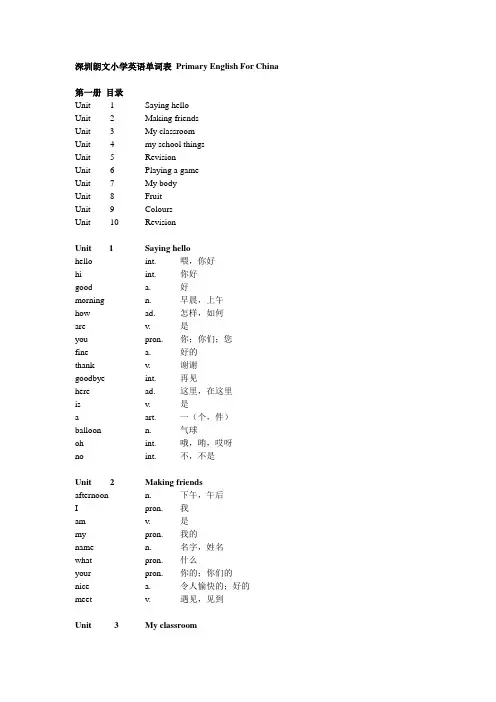
深圳朗文小学英语单词表Primary English For China第一册目录Unit 1 Saying helloUnit 2 Making friendsUnit 3 My classroomUnit 4 my school thingsUnit 5 RevisionUnit 6 Playing a gameUnit 7 My bodyUnit 8 FruitUnit 9 ColoursUnit 10 RevisionUnit 1 Saying hellohello int. 喂,你好hi int. 你好good a. 好morning n. 早晨,上午how ad. 怎样,如何are v. 是you pron. 你;你们;您fine a. 好的thank v. 谢谢goodbye int. 再见here ad. 这里,在这里is v. 是a art. 一(个,件)balloon n. 气球oh int. 哦,哊,哎呀no int. 不,不是Unit 2 Making friendsafternoon n. 下午,午后I pron. 我am v. 是my pron. 我的name n. 名字,姓名what pron. 什么your pron. 你的;你们的nice a. 令人愉快的;好的meet v. 遇见,见到Unit 3 My classroomit pron. 它computer n. 计算机;电脑desk n. 书桌chair n. 椅子fan n. 风扇;扇子light n. 灯,灯光book n. 书;本子this pron. 这,这个classroom n. 教室sorry a. 对不起,抱歉miss n. 小姐,女士(称呼未婚女子)Unit 4 My school thingsbag n. 书包pencil n. 铅笔pencil Case 铅笔盒pen n. 钢笔ruler n. 尺子rubber n. 橡皮Unit 6 Playing a gamepoint v. 指,指向point to 指向the art. 这(那)个,这(那)些board n. 黑板door n. 门window n. 窗户look v. 看,观看look at (仔细)检查,查看sit v. 坐sit down 坐下stand v. 站stand up 起立open v. 打开close v. 关,关上out adv 出局,淘汰children n. (复)孩子,儿童Mr(Mister)n. 先生(用于姓名前)please ad. 请Unit 7 My bodymouth n. 嘴nose n. 鼻子eye n. 眼睛ear n. 耳朵finger n. 手指draw v. 画画one num. 一two num. 二three num. 三four num. 四five num. 五six num. 六seven num. 七eight num. 八nine num. 九ten num. 十yes ad. 是and conj 和Unit 8 Fruitan art 一(个,件)apple n. 苹果banana n. 香蕉pear n. 梨子lychee n. 荔枝orange n. 橙子mum n. (口语)妈妈fruit n. 水果salad n. 色拉Unit 9 Coloursred a. 红色blue a. 蓝色yellow a. 黄色green a. 绿色orange a. 橙色brown a. 褐色的,棕色的me pron. 我(宾格)very ad. 很,非常too ad. 也,还ow int. 啊哊,哦第二册目录Unit 1 About meUnit 2 Fun with KOKOUnit 3 Our showUnit 4 At the zooUnit 5 RevisionUnit 6 ToysUnit 7 My petUnit 8 Children`s DayUnit 9 Fantasy WorldUnit 10 RevisionUnit 1 About mestudent n. 学生young a. 年轻的pioneer n. 先锋,开拓者Young Pioneer 少先队员in prep. 在……里面class n. 班级grade n. 年级boy n. 男孩girl n. 女孩what int. 什么(表示惊讶)turn n. (轮流的)顺序It's your turn. 轮到你了。
英语教案my body一、教学内容本节课选自《新概念英语》第一册第四章,详细内容为"My Body"。
通过本章学习,学生将认识并掌握关于身体各部位的英语表达,包括head、eye、ear、nose、mouth、arm、hand、leg和foot。
二、教学目标1. 能够听懂并准确说出关于身体部位的英语单词。
2. 能够运用所学单词进行简单的句子表达,如:“This is my head.”。
3. 能够通过小组合作,完成身体部位的配对游戏。
三、教学难点与重点难点:身体部位单词的准确发音及句子表达。
重点:掌握身体部位的英语单词,并能灵活运用。
四、教具与学具准备教具:PPT、卡片、身体部位道具。
学具:课本、练习本、彩笔。
五、教学过程1. 实践情景引入(5分钟)教师展示身体部位道具,引导学生说出中文。
教师用英语重复身体部位,让学生模仿发音。
2. 新课内容展示(10分钟)教师播放PPT,展示身体部位图片,教授单词。
教师引导学生跟读,并纠正发音。
教师用身体动作展示单词,让学生模仿。
3. 例题讲解(5分钟)教师展示例句:“This is my head.”,并进行讲解。
教师邀请学生上台演示,并鼓励其他学生跟读。
4. 随堂练习(10分钟)教师发放身体部位卡片,学生进行配对游戏。
教师邀请学生上台展示,并给予表扬。
5. 小组合作(5分钟)学生分成小组,用所学单词进行身体部位接龙。
教师巡回指导,纠正发音。
教师收集学生反馈,了解学习效果。
六、板书设计1. 板书My Body2. 板书内容:身体部位单词:head、eye、ear、nose、mouth、arm、hand、leg、foot示例句子:This is my head.七、作业设计1. 作业题目:用所学身体部位单词,画一幅自己的身体部位图,并标注英文。
2. 答案:学生根据所学内容,完成身体部位图。
八、课后反思及拓展延伸2. 拓展延伸:邀请家长参与,让学生用所学单词介绍家人。
THE STUDENTS IN MY ENGLISH CLASS P13The students in my English class are very interesting. Henry is Chinese. He’s from Shanghai. Linda is Poerto Rican. She’s fromSan Juan. Mr. And Mrs.Kim are Korean.They’re from Seoul.George is Greek. He’s from Athens.Carla is Italian. She’s from Rome. Mr. AndMrs. Sato are Japanese. They’re from Tokyo.My friend Maria and I are Mexican. We’refrom Mexico City.Yes, the students in my English class arevery interesting. We’re from many different countries... and we’re friends.ALL THE STUDENTS IN MY ENGLISH P15 CLASS ARE ABSENT TODAYAll the students in my English class areabsent today. George is absent. He’s in the Hospital. Maria is absent. She’s at the dentist. Mr. And Mrs. Sato are absent. They’re at the social security office. Even our English teacher is absent. He’s homein bed!What a shame! Everybody in my English class is absent today. Everybody except me.IN THE PARK P22The Jones family is in the park today. The sun is shining, and the birds are singing. It’s a beautiful day!Mr. Jones is reading the newspaper. Mrs. Jones is listening to the radio. Sally and Patty Jones are studying. And Tommy Jones is playing the guitar.The Jones family is very happy today.It’s a beautiful day, and they’re in the park.AT HOME IN THE YARDThe Chen family is at home in the yard today. The sun is shining, and the birds are singing. It’s a beautiful day!Mr. Chen is planting flowers. Mrs. Chen Is drinking lemonade and reading a book. Emily and Jason Chen are playing with the dog. And Jennifer Chen is sleeping.The Chen family is very happy today.It’s a beautiful day, and they’re at home in the yard.。
深圳朗文小学英语单词表Primary English For China 第一册目录Unit 1 Saying hello Unit 2 Making friends Unit 3 My classroom Unit 4 my school things Unit 5 Revision Unit 6 Playing a game Unit 7 My bodyUnit 8 FruitUnit 9 ColoursUnit 10 RevisioUnit 1 Saying hellohello int. 喂,你好hi int. 你好good a. 好morning n. 早晨,上午how ad. 怎样,如何are v. 是you pron. 你;你们;您fine a. 好的thank v. 谢谢goodbye int. 再见here ad. 这里,在这里is v. 是a art. 一(个,件)balloon n. 气球oh int. 哦,哊,哎呀no int. 不,不是Unit 2 Making friendsafternoon n. 下午,午后I pron. 我am v. 是my pron. 我的name n. 名字,姓名what pron. 什么your pron. 你的;你们的nice a. 令人愉快的;好的meet v. 遇见,见到Unit 3 My classroomit pron. 它computer n. 计算机;电脑desk n. 书桌chair n. 椅子fan n. 风扇;扇子light n. 灯,灯光book n. 书;本子this pron. 这,这个classroom n. 教室sorry a. 对不起,抱歉miss n. 小姐,女士(称呼未婚女子)Unit 4 My school thingsbag n. 书包pencil n. 铅笔pencil Case 铅笔盒pen n. 钢笔ruler n. 尺子rubber n. 橡皮Unit 6 Playing a gamepoint v. 指,指向point to 指向the art. 这(那)个,这(那)些board n. 黑板door n. 门window n. 窗户look v. 看,观看look at (仔细)检查,查看sit v. 坐sit down 坐下stand v. 站stand up 起立open v. 打开close v. 关,关上out adv 出局,淘汰children n. (复)孩子,儿童Mr(Mister)n. 先生(用于姓名前)please ad. 请Unit 7 My bodymouth n. 嘴nose n. 鼻子eye n. 眼睛ear n. 耳朵finger n. 手指draw v. 画画one num. 一two num. 二three num. 三four num. 四five num. 五six num. 六seven num. 七eight num. 八nine num. 九ten num. 十yes ad. 是and conj 和Unit 8 Fruitan art 一(个,件)apple n. 苹果banana n. 香蕉pear n. 梨子lychee n. 荔枝orange n. 橙子mum n. (口语)妈妈fruit n. 水果salad n. 色拉Unit 9 Coloursred a. 红色blue a. 蓝色yellow a. 黄色green a. 绿色orange a. 橙色brown a. 褐色的,棕色的me pron. 我(宾格)very ad. 很,非常too ad. 也,还ow int. 啊哊,哦第二册目录Unit 1 About meUnit 2 Fun with KOKO Unit 3 Our showUnit 4 At the zooUnit 5 Revision Unit 6 ToysUnit 7 My petUnit 8 Children`s Day Unit 9 Fantasy World Unit 10 RevisionUnit 1 About mestudent n. 学生young a. 年轻的pioneer n. 先锋,开拓者Young Pioneer 少先队员in prep. 在……里面class n. 班级grade n. 年级boy n. 男孩girl n. 女孩what int. 什么(表示惊讶)turn n. (轮流的)顺序It's your turn. 轮到你了。